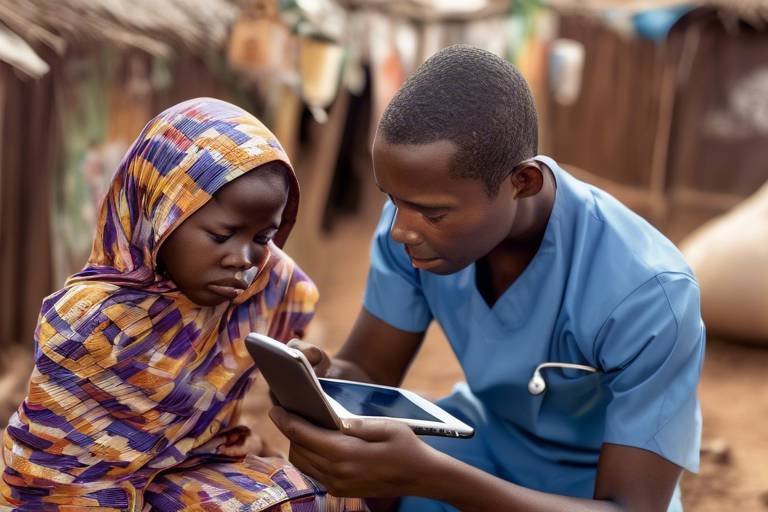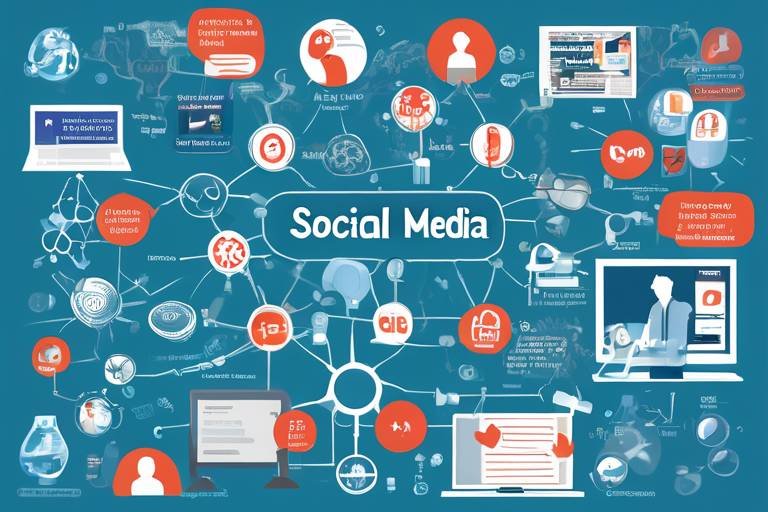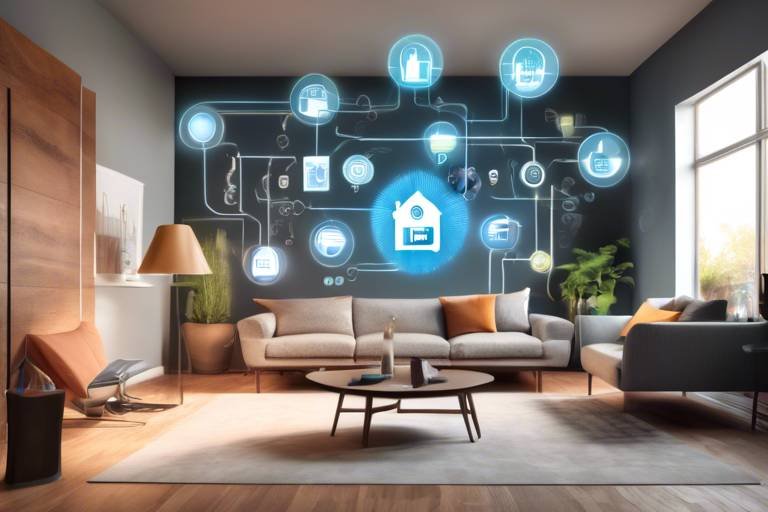How Technology is Influencing Community Health Initiatives
In today's fast-paced world, technology is not just a tool; it's a game-changer, especially when it comes to community health initiatives. Imagine a world where healthcare is not confined to hospital walls, where information flows freely, and where individuals take charge of their health with just a few taps on their smartphones. This is the reality that technology is creating, and it's transforming how communities engage with health resources. From remote consultations to mobile health applications, the influence of technology is profound and far-reaching.
One of the most significant advancements in healthcare technology is telemedicine. This innovation allows patients to connect with healthcare professionals from the comfort of their homes. For communities in underserved areas, where access to medical facilities is often limited, telemedicine is nothing short of revolutionary. It breaks down geographical barriers and ensures that everyone has a chance to receive quality care. However, it's not without its challenges. Issues like internet accessibility and the digital divide can hinder its effectiveness. Still, the potential benefits are immense, making it a vital component of modern health initiatives.
Moreover, mobile health applications are empowering individuals to take a proactive approach to their health. These apps are designed to track everything from daily steps to dietary habits, allowing users to monitor their progress and stay motivated. The beauty of these applications lies in their ability to personalize health management, making it easier for users to adopt healthier behaviors. For instance, an app might remind you to drink water throughout the day or encourage you to take a walk after dinner. This kind of engagement fosters a sense of community, as individuals often share their goals and achievements with friends and family, creating a support network that promotes accountability.
When we delve deeper, we find that technology also plays a crucial role in behavioral health support. Mental health apps provide resources that help individuals cope with stress, anxiety, and other mental health issues. These platforms can connect users to therapists or support groups, making help more accessible than ever. In addition, peer support networks facilitated by technology foster community engagement. They allow individuals to share their experiences and support one another, enhancing overall mental health and well-being.
However, as we embrace these technological advancements, we must also be mindful of data privacy concerns. With the increasing amount of personal health data being shared online, maintaining confidentiality is paramount. Users must trust that their information is secure, which is why health platforms must prioritize robust security measures. Balancing the benefits of technology with the need for privacy is a challenge that the industry must navigate carefully.
Another critical aspect of technology in community health is health education and awareness. Digital platforms serve as essential channels for disseminating information about health issues, preventive measures, and healthy lifestyle choices. For example, social media campaigns can effectively raise awareness about diseases or promote vaccination drives. By leveraging technology, communities can enhance knowledge sharing and encourage healthier behaviors among their members.
As we look to the future, wearable health technology is poised to take center stage. Devices like fitness trackers and smartwatches offer real-time health monitoring, enabling users to keep tabs on their physical activity, heart rate, and even sleep patterns. This immediate feedback can motivate individuals to make healthier choices and stay engaged in their health journey. Furthermore, these wearables can play a significant role in chronic disease management, helping patients monitor their conditions and communicate effectively with healthcare providers.
In conclusion, the influence of technology on community health initiatives is undeniable. From telemedicine to mobile health apps and wearable devices, technology is reshaping how we think about and manage our health. As we embrace these changes, it's essential to remain vigilant about privacy concerns and ensure that all community members can access these resources. The future of health engagement is bright, and with continued innovation, we can look forward to healthier communities.
- How does telemedicine improve access to healthcare? Telemedicine allows patients to consult with healthcare professionals remotely, making it easier for those in underserved areas to receive care.
- What are the benefits of mobile health applications? These apps help individuals track their health, set goals, and receive personalized reminders, promoting proactive health management.
- How can technology support mental health? Technology provides access to resources, therapy, and peer support, making mental health care more accessible.
- What are the privacy concerns related to digital health? The sharing of personal health data raises concerns about confidentiality, making it crucial for health platforms to implement strong security measures.
- How can wearables assist in chronic disease management? Wearable devices allow patients to monitor their conditions in real-time, facilitating better communication with healthcare providers.
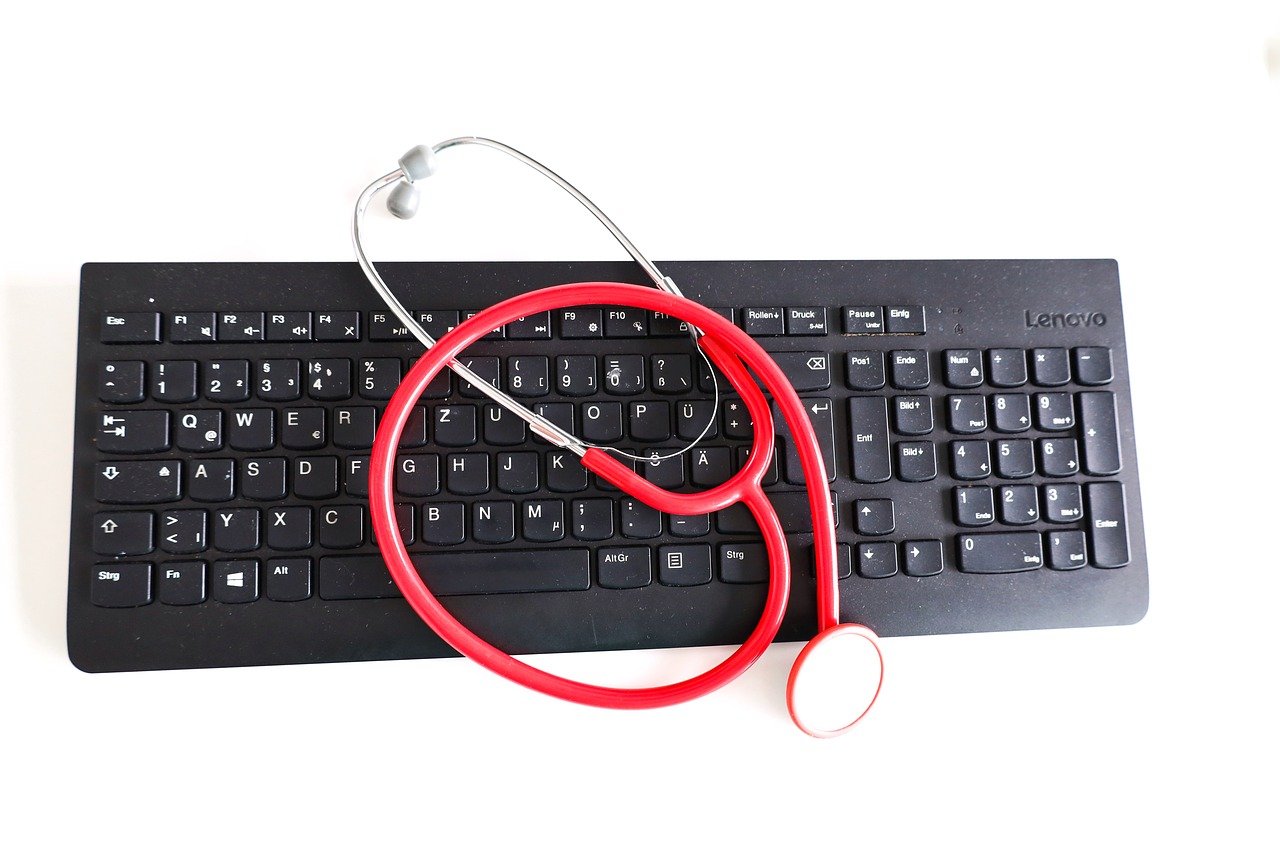
The Role of Telemedicine
Telemedicine has truly revolutionized the way we think about healthcare delivery. Imagine being able to consult with a doctor from the comfort of your own home, without the hassle of long waiting times or travel. This convenience is especially crucial for individuals living in underserved areas, where access to healthcare facilities may be limited. With just a smartphone or computer, patients can connect with medical professionals, receive diagnoses, and even get prescriptions—all with a few clicks. This not only saves time but also enhances the overall efficiency of healthcare services.
However, while the benefits of telemedicine are numerous, it’s essential to recognize the challenges that come with it. For instance, not everyone has equal access to the technology required for telemedicine. Issues such as internet connectivity and digital literacy can create barriers for some individuals, particularly the elderly or low-income populations. Moreover, there are concerns regarding the quality of care provided through virtual consultations compared to in-person visits. To address these challenges, it's crucial for healthcare providers and policymakers to work together to ensure that telemedicine is accessible and effective for everyone.
One of the most significant advantages of telemedicine is its ability to enhance community health initiatives. By facilitating remote consultations, healthcare providers can reach out to patients who may have previously avoided seeking medical help due to geographical or logistical barriers. This is particularly important for managing chronic diseases, where regular check-ins can lead to better health outcomes. Telemedicine also allows for real-time monitoring of patients, enabling healthcare professionals to adjust treatments quickly based on the patient’s current condition.
Furthermore, telemedicine can play a pivotal role in public health campaigns. For example, during a health crisis like the COVID-19 pandemic, telemedicine became a lifeline for many. It provided a platform for disseminating vital information about the virus, vaccination, and preventive measures. Through virtual town halls and online consultations, healthcare providers could engage with the community, answering questions and addressing concerns in real-time.
In summary, while telemedicine presents certain challenges, its benefits are undeniable. It not only increases access to healthcare but also enhances the effectiveness of community health initiatives. As technology continues to advance, the potential for telemedicine to improve health outcomes and foster community engagement will only grow. The future of healthcare is here, and it’s more connected than ever before.

Mobile Health Applications
In today's fast-paced world, have emerged as game changers in the healthcare landscape, enabling individuals to take charge of their health like never before. Imagine having a personal health assistant right in your pocket, ready to provide you with insights about your well-being at any moment. These apps are not just tools; they are empowering platforms that encourage proactive health management, making it easier for people to adopt and maintain healthier lifestyles.
One of the most exciting aspects of mobile health applications is their diversity in features. From tracking daily activities and monitoring vital signs to providing medication reminders and offering personalized health advice, these applications cater to a wide range of health needs. With the advent of technology, users can now access a plethora of information and services, enhancing their ability to manage health conditions or simply stay fit. For instance, many apps allow users to log their food intake, track exercise routines, and even connect with healthcare professionals for virtual consultations.
Moreover, the role of mobile health applications extends beyond individual use; they are crucial in promoting healthy behaviors within communities. By integrating social features, these apps create a sense of community and accountability among users. For example, some applications allow users to join challenges, share progress, and motivate each other, fostering a supportive environment. This sense of camaraderie can be a powerful motivator, encouraging users to stick to their health goals and engage in healthier habits.
However, while the advantages of mobile health applications are numerous, they are not without challenges. One significant concern is the digital divide, where not everyone has equal access to smartphones or the internet. This disparity can lead to inequalities in health management, particularly in underserved communities. Additionally, the effectiveness of these applications largely depends on user engagement. If individuals do not regularly use the app or fail to input their data, the potential benefits diminish significantly.
Another critical aspect to consider is the issue of data privacy. With sensitive health information being collected and stored, users must be cautious about the applications they choose to use. It’s essential for developers to implement robust security measures to protect user data, and for users to be informed about their rights regarding data sharing and privacy. Transparency is key; users need to trust that their information is safe and used responsibly.
In conclusion, mobile health applications represent a significant leap forward in community health initiatives. They empower individuals to take control of their health, promote healthier behaviors, and foster a sense of community. As technology continues to evolve, the potential for these applications to improve health outcomes will only grow. By addressing challenges such as access and privacy, we can harness the full potential of mobile health technology to create healthier communities.
- What are mobile health applications?
Mobile health applications are software programs designed to run on smartphones and tablets that help users manage their health and wellness.
- How can mobile health apps improve my health?
These apps can help you track your physical activity, monitor your diet, remind you of medications, and even connect you with healthcare professionals.
- Are mobile health applications secure?
While many apps implement strong security measures, it's essential to choose reputable apps and be aware of their privacy policies to protect your data.

Behavioral Health Support
In today's fast-paced world, mental health has taken center stage, and technology is stepping in as a vital ally in this arena. Behavioral health support has evolved dramatically with the introduction of various digital tools and platforms, making it easier than ever for individuals to access the help they need. Imagine being able to reach out for support from the comfort of your own home, without the stigma that sometimes accompanies traditional therapy settings. This is the promise that technology brings to behavioral health.
One of the most significant advancements is the availability of mental health apps. These applications often provide a plethora of resources, including guided meditations, mood tracking, and cognitive behavioral therapy (CBT) exercises. Users can engage with these tools at their own pace, which can be incredibly empowering. For instance, someone struggling with anxiety can use an app to practice breathing exercises or mindfulness techniques whenever they feel overwhelmed, creating a sense of control over their mental state.
Moreover, online platforms have made it possible to connect with mental health professionals via teletherapy. This means that individuals in remote areas or those with mobility challenges can access quality care without traveling long distances. The convenience of scheduling sessions around personal commitments also enhances adherence to treatment plans. It’s like having a therapist in your pocket, ready to listen whenever you need them.
Additionally, the rise of peer support networks facilitated by technology cannot be overlooked. These networks allow individuals to share their experiences and challenges with others who understand their struggles. For example, online forums and social media groups provide safe spaces for people to discuss mental health topics, share coping strategies, and offer encouragement. This sense of community can be incredibly healing, as it fosters connections that remind individuals they are not alone in their journey.
However, it’s essential to acknowledge that while technology provides numerous benefits, it also comes with challenges, particularly regarding data privacy. Users often share sensitive information on these platforms, which raises concerns about confidentiality. Ensuring that mental health applications and teletherapy services adhere to strict privacy standards is crucial in building trust with users. After all, no one wants to feel vulnerable while seeking help, only to worry about their personal information being compromised.
In summary, technology is reshaping the landscape of behavioral health support, making it more accessible and user-friendly. From mental health apps to teletherapy and peer support networks, individuals now have a variety of resources at their fingertips. As we continue to embrace these innovations, it's vital to remain vigilant about privacy concerns and ensure that these tools are used responsibly. The future of mental health support is bright, and with the right balance of technology and compassion, we can foster a healthier society.
- What types of mental health apps are available? There are various apps focusing on mindfulness, mood tracking, therapy exercises, and even direct connections to therapists.
- Is teletherapy as effective as in-person therapy? Research suggests that teletherapy can be just as effective as traditional therapy for many individuals, especially when it comes to accessibility.
- How can I ensure my data is safe when using mental health apps? Look for apps that comply with privacy regulations and have clear privacy policies detailing how your data is used and protected.

Peer Support Networks
In today's fast-paced world, the significance of cannot be overstated. These networks, often facilitated through technology, create a sense of community and belonging among individuals facing similar challenges, particularly in the realm of mental health. Imagine walking into a room filled with people who understand your struggles, who share their experiences, and who uplift one another. That’s the essence of peer support. It’s like having a safety net, where every thread is woven from shared experiences and empathy.
Technology has transformed the way these networks operate. With just a smartphone or a computer, individuals can connect with others across the globe, sharing their stories and offering support. Platforms like Facebook groups, dedicated forums, and mental health apps have become popular spaces for these interactions. They allow people to seek advice, share coping strategies, and provide emotional support, creating a virtual community that can be just as impactful as face-to-face interactions.
One of the most compelling aspects of peer support networks is their ability to reduce the stigma surrounding mental health issues. When individuals see others openly discussing their experiences, it fosters a culture of acceptance and understanding. This is crucial because many people still feel isolated in their struggles, often believing that they are alone in their feelings. Peer support networks challenge this notion, reminding individuals that they are part of a larger community.
Moreover, these networks often incorporate various forms of communication, including video calls, chat rooms, and social media platforms, which enhance engagement and interaction. For instance, online support groups can host live discussions on topics such as anxiety management or coping with depression, allowing members to share their insights in real-time. This dynamic exchange of information can lead to increased awareness and education about mental health, ultimately empowering individuals to take charge of their well-being.
However, it’s important to note that while peer support networks offer numerous benefits, they also come with challenges. Maintaining a safe and respectful environment is crucial, as not all interactions may be positive. Moderation and guidelines are essential to ensure that the space remains supportive and constructive. Additionally, individuals must be cautious about the information shared and received, as not all advice may be appropriate or helpful.
In conclusion, peer support networks are a powerful tool in the realm of community health initiatives. They not only provide emotional support but also foster a sense of belonging and acceptance. As technology continues to evolve, these networks will likely become even more integral to mental health support, bridging gaps and connecting individuals in ways that were previously unimaginable.
- What are peer support networks? Peer support networks are groups of individuals who share similar experiences and provide emotional and practical support to one another, often facilitated through technology.
- How do peer support networks help with mental health? They create a sense of community, reduce stigma, and provide a platform for sharing experiences and coping strategies, which can enhance mental well-being.
- Can peer support networks be found online? Yes, many peer support networks operate online through social media, forums, and dedicated mental health apps, allowing for global connectivity.
- What challenges do peer support networks face? Challenges include ensuring a safe environment, managing negative interactions, and verifying the accuracy of shared information.

Data Privacy Concerns
In this digital age, where technology is seamlessly woven into our daily lives, the concerns surrounding data privacy have become a hot topic, particularly in the realm of community health initiatives. As we embrace innovative solutions like telemedicine, mobile health applications, and wearable technology, the question arises: how secure is our personal health information? The reality is, while these tools offer incredible benefits, they also expose sensitive data to potential breaches and misuse.
Imagine sharing your health data with an app designed to monitor your fitness levels or track your mental health progress. You might feel empowered, but what if that data fell into the wrong hands? The fear of identity theft or unauthorized access to personal health records is a legitimate concern for many individuals. According to a recent study, over 60% of people expressed anxiety about their health data being shared without consent. This statistic highlights the need for stringent privacy measures in the health tech industry.
Many digital health platforms collect vast amounts of data, including personal identifiers, medical histories, and even real-time health metrics. This data can be invaluable for improving community health outcomes, but it also raises ethical questions about ownership and consent. To mitigate these risks, it’s essential for users to understand how their data is being used. Here are some critical points to consider:
- Informed Consent: Users should be fully aware of what data is collected and how it will be utilized.
- Data Encryption: Ensuring that health data is encrypted can protect it from unauthorized access.
- Transparency: Health apps should provide clear privacy policies that outline data usage.
Moreover, regulatory frameworks like the Health Insurance Portability and Accountability Act (HIPAA) in the United States are designed to protect patient information. However, not all apps and platforms fall under these regulations, especially those that are not directly affiliated with healthcare providers. This creates a gray area where users may unknowingly expose their data to risks.
As we move forward, fostering a culture of data privacy awareness is crucial. Community health initiatives must prioritize the implementation of robust security measures to build trust among users. This means not only protecting data but also educating individuals about their rights and the importance of safeguarding their personal information. After all, in a world where our health is increasingly monitored and digitized, maintaining privacy is not just a luxury; it’s a necessity.
In conclusion, while technology holds the potential to transform community health initiatives positively, we must remain vigilant about the implications of data privacy. It’s a balancing act between leveraging the benefits of digital tools and ensuring that individuals feel secure in sharing their health information. The future of health engagement will depend on our ability to navigate these challenges effectively.
- What is data privacy in health technology? Data privacy refers to the protection of personal health information collected by digital health tools from unauthorized access and misuse.
- How can I ensure my health data is secure? Always read the privacy policies of health applications and ensure they use encryption and have clear consent processes.
- What are the risks of sharing health data? Risks include identity theft, unauthorized use of data, and potential breaches of confidentiality.

Health Education and Awareness
In today’s fast-paced world, are more critical than ever. With the rise of digital platforms, communities now have unprecedented access to information that can empower individuals to make informed health choices. Imagine having a wealth of knowledge at your fingertips—this is what technology offers. From online courses to interactive webinars, the resources available for health education are vast and varied.
One of the most significant advantages of utilizing technology for health education is the ability to reach a broader audience. Traditional methods of education often limit engagement to physical locations, but with digital tools, information can be disseminated globally. For instance, a community health initiative can host a live-streamed session on nutrition, allowing participants from different regions to join in and learn. This not only enhances knowledge sharing but also fosters a sense of community among participants who may never have met otherwise.
Moreover, technology enables personalized learning experiences. Through mobile applications and online platforms, individuals can access content tailored to their specific health needs. For example, someone managing diabetes can find resources specifically designed for their condition, including meal plans, exercise routines, and monitoring tools. This level of personalization makes health education more relevant and effective.
To illustrate the impact of technology on health education, consider the following table that highlights various digital tools and their benefits:
| Digital Tool | Benefits |
|---|---|
| Webinars | Interactive sessions that allow for real-time questions and engagement. |
| Mobile Apps | Personalized health tracking and reminders for medication and appointments. |
| Social Media Campaigns | Widespread outreach and community engagement through shared experiences. |
| Online Forums | Support networks where individuals can share experiences and advice. |
However, while the benefits are substantial, it’s essential to address the challenges associated with digital health education. The sheer volume of information available can sometimes lead to confusion or misinformation. Therefore, it’s crucial for communities to promote trusted sources and ensure that educational content is accurate and reliable. Collaborating with healthcare professionals to create and verify content can significantly enhance the credibility of health education efforts.
In conclusion, technology has transformed the landscape of health education and awareness, making it more accessible and personalized than ever before. By leveraging digital tools, communities can empower individuals to take charge of their health, ultimately leading to healthier lifestyles and improved well-being. As we continue to embrace these innovations, it’s vital to remain vigilant about the quality of information being shared, ensuring that everyone can benefit from the wealth of knowledge available in the digital age.
- How can I find reliable health information online? Look for websites that are backed by reputable health organizations, universities, or government agencies.
- What are some effective ways to engage my community in health education? Organize workshops, webinars, and use social media to share valuable resources and information.
- Can mobile health apps really help with disease management? Yes, many apps are designed to assist with monitoring conditions, tracking symptoms, and providing reminders for medication.

Wearable Health Technology
In recent years, has emerged as a game-changer in the realm of personal health management. These devices, which range from smartwatches to fitness trackers, have become increasingly popular among individuals looking to take charge of their health. Imagine having a personal health assistant right on your wrist, constantly monitoring your vital signs, activity levels, and even your sleep patterns. This technology not only empowers individuals to make informed health decisions but also plays a significant role in enhancing community health initiatives. But how exactly does it work, and what impact does it have on our health?
One of the most remarkable aspects of wearable technology is its ability to provide real-time health monitoring. For instance, devices can track heart rates, calorie burn, and physical activity levels, allowing users to set and achieve personal fitness goals. By collecting data continuously, these wearables can alert users to any irregularities in their health, such as elevated heart rates during rest, which could indicate a potential health issue. This proactive approach is especially beneficial for managing chronic diseases. For example, individuals with diabetes can use wearables to monitor their blood sugar levels, enabling them to react promptly to any fluctuations.
Moreover, the integration of wearable technology into community health initiatives can foster a culture of health awareness and engagement. Communities can organize fitness challenges where participants wear devices that track their activity levels, creating a sense of friendly competition. This not only encourages individuals to be more active but also strengthens community bonds as people come together to support one another in achieving their health goals. For instance, a neighborhood might host a month-long walking challenge, where participants can share their progress on social media, motivating others to join in and stay active.
However, the journey of wearable health technology isn't without its challenges. One significant concern is the data privacy of users. As these devices collect sensitive health information, ensuring that this data is stored securely and used responsibly is paramount. Users must be informed about how their data is being utilized and have control over their personal information. Companies developing these technologies are increasingly prioritizing data security measures, but users should remain vigilant and informed about the privacy policies of the devices they choose to use.
In conclusion, wearable health technology stands at the forefront of a health revolution, offering individuals the tools they need to monitor their health proactively. As communities embrace these innovations, the potential for improved health outcomes grows exponentially. By fostering engagement through challenges and ensuring the protection of personal data, wearable technology can pave the way for healthier populations and stronger community ties.
- What types of wearable health technology are available? Wearable health technology includes fitness trackers, smartwatches, heart rate monitors, and even smart clothing that tracks various health metrics.
- How can wearable devices help with chronic disease management? Wearable devices can provide continuous monitoring of vital signs and health metrics, allowing individuals to manage their conditions more effectively and alerting them to any concerning changes.
- Are there privacy concerns associated with wearable health technology? Yes, data privacy is a significant concern. Users should ensure that their devices have strong security measures and be aware of how their data is being collected and used.

Fitness Tracking and Community Challenges
In today's fast-paced world, fitness tracking technology has emerged as a game-changer, not just for personal health but also for building community spirit. Imagine a neighborhood where everyone is not only aware of their fitness goals but is also actively engaged in achieving them together. This is the magic of fitness tracking devices, which allow individuals to monitor their activity levels, heart rates, and even sleep patterns. But the real power comes when these devices are integrated into community challenges that foster a sense of camaraderie and collective motivation.
Community challenges, often organized through fitness tracking apps, create a platform for friendly competition and collaboration. Participants can join teams, set collective goals, and share their progress in real-time. This not only makes fitness fun but also encourages accountability. For instance, a local gym might launch a "30-Day Step Challenge" where participants aim to collectively walk a million steps. The excitement builds as teams cheer each other on, share tips, and celebrate milestones together. It's like turning exercise into a social event!
Moreover, these challenges often come with rewards, such as discounts at local health food stores or free classes at community centers. Not only do participants get fit, but they also enjoy a sense of achievement and community bonding. These initiatives can significantly impact overall health outcomes in communities, as they promote not just physical activity but also social interaction, which is crucial for mental health.
However, while the benefits are clear, the implementation of such challenges is not without its hurdles. Technology can sometimes be a barrier for those who are less tech-savvy or lack access to devices. To address this, communities can organize events where participants can borrow devices or receive tutorials on how to use fitness apps effectively. This inclusivity ensures that everyone has a chance to participate, regardless of their starting point.
In conclusion, fitness tracking and community challenges represent a powerful synergy that can transform health engagement. By leveraging technology, communities can inspire individuals to adopt healthier lifestyles while fostering connections that enhance overall well-being. So, why not lace up those sneakers and join a local challenge? You might just find that getting fit is a lot more enjoyable when you do it with friends!
- What are fitness tracking devices? Fitness tracking devices are gadgets or apps that monitor physical activity, heart rate, sleep patterns, and other health metrics.
- How do community challenges work? Community challenges involve groups of individuals competing or collaborating to reach fitness goals, often tracked through fitness apps.
- Can anyone join a community fitness challenge? Yes! Most community fitness challenges are open to everyone, regardless of fitness level.
- What are the benefits of participating in community challenges? Benefits include increased motivation, social connections, and improved physical health.

Chronic Disease Management
Chronic diseases, such as diabetes, hypertension, and heart disease, are among the leading causes of morbidity and mortality worldwide. Managing these conditions can often feel like a daunting task, but technology is here to change the game. Imagine having a personal health assistant right on your wrist or in your pocket, ready to help you track your vitals, medication schedules, and even offer reminders for your next doctor's appointment. This is the power of wearable health technology, which is revolutionizing chronic disease management.
Wearable devices, such as smartwatches and fitness trackers, have become essential tools for individuals managing chronic illnesses. They collect real-time data about a person's health, allowing for proactive management rather than reactive treatment. For instance, a diabetic patient can monitor their blood glucose levels throughout the day, receiving alerts when their levels are too high or too low. This immediate feedback enables them to make informed decisions about their diet and medication, ultimately leading to better health outcomes.
Moreover, these devices often come equipped with features that can connect users to healthcare providers. Telehealth services integrated into these platforms mean that patients can share their data with doctors in real-time. This not only enhances the relationship between patients and healthcare professionals but also allows for timely interventions when necessary. Imagine being able to have a virtual consultation with your doctor, where they can analyze your health data and provide personalized advice without you ever having to leave your home. This is not just a dream; it’s becoming a reality for many.
However, it's essential to recognize that while technology offers these incredible benefits, there are also challenges that come with it. For example, some patients may struggle with the technology itself—whether it's the complexity of the devices or the data interpretation. Additionally, there are concerns about data privacy and security. Patients need to trust that their sensitive health information is protected, which is why it’s crucial for companies to prioritize robust security measures.
In terms of chronic disease management, the integration of technology can be broken down into several key benefits:
- Enhanced Monitoring: Continuous tracking of health metrics such as heart rate, blood pressure, and physical activity.
- Improved Communication: Direct lines of communication between patients and healthcare providers, facilitating timely interventions.
- Personalized Care: Tailored treatment plans based on real-time data, allowing for adjustments to be made as needed.
- Increased Engagement: Encouraging patients to take an active role in their health management through gamification and challenges.
In conclusion, as chronic diseases continue to rise, the integration of technology into health management is not just beneficial; it is essential. By empowering patients with tools that provide real-time data and fostering a collaborative relationship with healthcare providers, we can improve health outcomes and enhance the quality of life for those living with chronic conditions. The future of chronic disease management is bright, and it’s all thanks to the innovative solutions that technology offers.
- What types of chronic diseases can be managed with wearable technology? Wearable technology can assist in managing various chronic diseases, including diabetes, hypertension, asthma, and heart disease.
- How do I choose the right wearable device for my needs? Consider the specific health metrics you need to monitor, compatibility with your smartphone, and features that align with your lifestyle.
- Are there privacy concerns with wearable health technology? Yes, it’s important to ensure that any device you use has strong security measures in place to protect your personal health data.
- Can wearable technology replace regular doctor visits? While wearable technology can enhance monitoring and communication, it should complement regular check-ups rather than replace them.
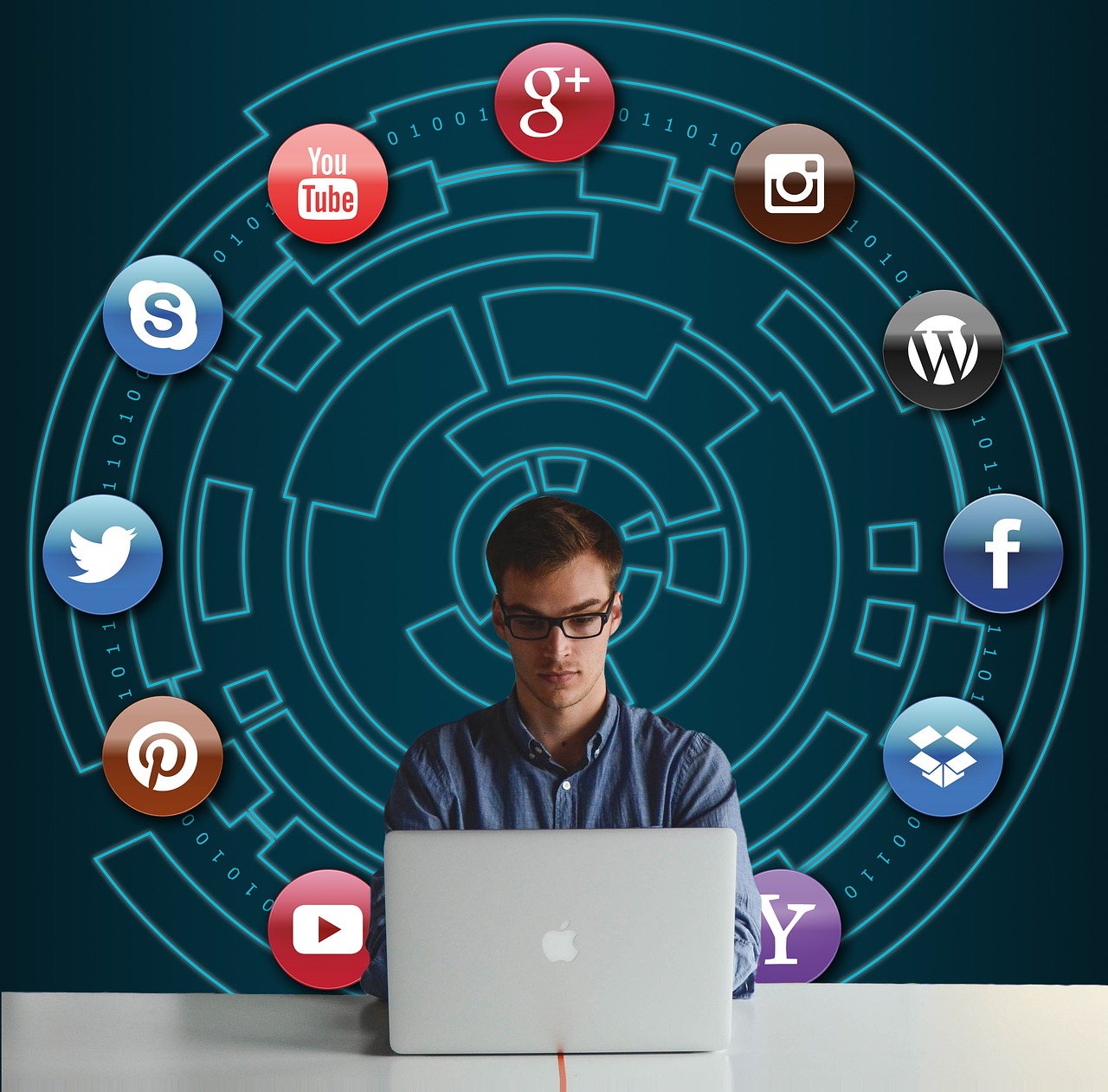
Social Media and Health Promotion
In today's digital age, social media has emerged as a powerful ally in the realm of health promotion. With billions of users globally, platforms like Facebook, Instagram, Twitter, and TikTok are not just for social interaction; they have become vital channels for disseminating health information. Imagine a world where health tips, awareness campaigns, and community support are just a click away. This is the reality we live in, and it's transforming how communities engage with health initiatives.
One of the most significant advantages of utilizing social media for health promotion is its ability to reach a diverse audience quickly. Health organizations and community leaders can share critical information about preventive measures, vaccination drives, and healthy lifestyle choices in real-time. For instance, during health crises such as the COVID-19 pandemic, social media played a crucial role in spreading awareness about safety protocols and vaccination availability. The immediacy of social media allows for rapid communication, which is essential in times of public health emergencies.
Moreover, social media platforms foster a sense of community among users. Individuals can share their health journeys, tips, and experiences, creating a supportive environment that encourages others to adopt healthier lifestyles. These interactions can be incredibly motivating. For example, a person who shares their weight loss journey might inspire others to embark on similar paths. The power of peer influence in these online spaces can lead to significant behavioral changes within communities.
However, while social media offers numerous benefits, it also presents challenges. The rampant spread of misinformation is a significant concern. False health claims can circulate rapidly, leading to confusion and harmful behaviors. To combat this, health organizations must actively engage in monitoring social media conversations and provide accurate information. Implementing strategies to promote reliable sources and educate users about identifying credible health information is crucial. Here are some effective strategies:
- Promote verified health sources, such as the World Health Organization (WHO) or the Centers for Disease Control and Prevention (CDC).
- Encourage critical thinking skills among users to discern between credible and non-credible information.
- Utilize engaging content formats, like infographics and videos, to convey accurate health messages effectively.
Furthermore, social media can also be leveraged to create engaging health campaigns. For instance, challenges or contests can be organized to promote physical activity or healthy eating. These campaigns not only spread awareness but also actively involve community members in health initiatives. The success of such campaigns often hinges on their ability to go viral, reaching audiences far beyond their initial scope.
In conclusion, social media is reshaping the landscape of health promotion. It serves as a platform for education, community building, and engagement, making health information more accessible than ever. As we navigate this digital era, harnessing the power of social media responsibly will be key to enhancing community health initiatives and ensuring that accurate health information prevails over misinformation.
Q: How can I ensure the health information I find on social media is accurate?
A: Always check the source of the information. Look for posts from reputable health organizations or professionals, and cross-reference with trusted health websites.
Q: Can social media really influence my health behaviors?
A: Yes! Social media can provide motivation, support, and information that can positively influence your health behaviors. Connecting with others who share similar health goals can be particularly encouraging.
Q: What should I do if I see misinformation about health on social media?
A: Report the post if possible, and consider sharing accurate information from reliable sources to counteract the misinformation.

Building Community Connections
In today's digital age, the power of social media extends far beyond just sharing memes and photos; it has become a vital tool for . Imagine walking into a room filled with people who share your interests, struggles, and aspirations. That’s what social media does for communities—it creates a virtual space where individuals can connect, collaborate, and support one another in their health journeys.
Social media platforms like Facebook, Twitter, and Instagram allow users to create groups and pages dedicated to specific health topics, from mental wellness to chronic disease management. These online communities serve as safe havens where individuals can share their experiences, ask questions, and provide support. For instance, a Facebook group focused on diabetes management can connect individuals facing similar challenges, enabling them to exchange tips, share recipes, and motivate one another. The sense of belonging that arises from these interactions can significantly enhance one’s commitment to health goals.
Moreover, social media facilitates the dissemination of important health information. Health organizations and community leaders can leverage these platforms to spread awareness about local health initiatives, vaccination drives, and wellness programs. By sharing engaging content—like videos, infographics, and live Q&A sessions—these organizations can reach a broader audience and encourage community participation.
However, it's not all sunshine and rainbows. The challenge lies in ensuring that the information shared is accurate and reliable. Misinformation can spread like wildfire on social media, leading to confusion and potentially harmful behaviors. Therefore, it’s crucial for community leaders to actively engage with their audiences, providing clear, evidence-based information while also encouraging discussions that help debunk myths.
To illustrate the impact of social media on community connections, consider the following table that outlines the benefits and challenges:
| Benefits | Challenges |
|---|---|
| Enhanced communication among community members | Spread of misinformation |
| Increased access to health resources | Privacy concerns |
| Opportunities for peer support and motivation | Digital divide affecting participation |
In conclusion, social media is a double-edged sword in the realm of health promotion. While it offers incredible opportunities for building connections and fostering community engagement, it also poses significant challenges that must be addressed. By prioritizing accurate information and fostering supportive online environments, communities can harness the full potential of social media to enhance health outcomes for all.
- How can I find health-related groups on social media? You can use the search function on platforms like Facebook or Reddit to find groups that focus on specific health issues.
- What should I do if I encounter misinformation? Report the misinformation to the platform and share accurate information from reliable sources.
- Are there privacy concerns with joining health groups online? Yes, it’s important to review the privacy settings of any group and be cautious about sharing personal information.

Challenges of Misinformation
Misinformation in health communication is like a double-edged sword; while social media can be a powerful tool for spreading awareness, it can also become a breeding ground for false information. The rapid dissemination of incorrect health data can lead to confusion, mistrust, and potentially harmful behaviors among community members. Imagine a game of telephone where the message gets distorted with each pass—this is what happens when health information is shared without proper verification. The consequences can be dire, especially in times of health crises when accurate information is crucial.
One of the primary challenges is the sheer volume of information available online. With countless sources at our fingertips, distinguishing between credible information and misinformation can be daunting. Many individuals lack the skills to critically evaluate the reliability of the sources they encounter. For instance, a study revealed that over 60% of people tend to trust health information that is shared by friends and family on social media, regardless of its accuracy. This trend raises questions about the effectiveness of traditional health communication strategies.
Moreover, the algorithms used by social media platforms often prioritize engagement over accuracy. Posts that evoke strong emotional responses are more likely to be shared, regardless of their factual basis. This can lead to a viral spread of misinformation, overshadowing scientifically sound health advice. To combat this issue, it is essential to implement strategies that promote critical thinking and source verification among community members.
Here are some strategies to address misinformation in health communication:
- Educational Campaigns: Launch campaigns that teach individuals how to identify credible sources and verify information.
- Partnerships with Influencers: Collaborate with trusted figures in the community to disseminate accurate health information.
- Fact-Checking Tools: Encourage the use of fact-checking websites and tools that can help individuals verify health claims.
Ultimately, addressing misinformation requires a community effort. By fostering an environment where individuals feel empowered to question and verify health information, we can create a more informed public. It’s not just about sharing information; it’s about sharing the right information. As we navigate this digital age, let’s strive to be vigilant and proactive in our approach to health communication.
Q1: What is misinformation in health communication?
A: Misinformation refers to false or misleading information that is spread, often unintentionally, which can lead to confusion and harmful behaviors in health contexts.
Q2: How can I identify credible health information?
A: Look for information from reputable sources such as government health agencies, established medical organizations, and peer-reviewed journals. Always check the author’s credentials and the date of publication.
Q3: Why is social media a problem for health communication?
A: Social media can amplify misinformation due to its viral nature, where emotionally charged content is shared widely, often without verification of facts.
Q4: What can communities do to combat misinformation?
A: Communities can organize educational campaigns, partner with local influencers, and promote the use of fact-checking tools to help individuals discern credible information.
Frequently Asked Questions
- What is telemedicine and how does it impact community health?
Telemedicine refers to the use of technology to provide medical care remotely. It significantly impacts community health by improving access to healthcare services, especially for individuals in underserved areas. Patients can consult with healthcare professionals without the need for travel, which is particularly beneficial for those with mobility issues or those living in rural locations.
- How can mobile health applications improve personal health management?
Mobile health applications empower users to take charge of their health by offering features like health tracking, medication reminders, and personalized health tips. These apps encourage proactive health management, helping individuals adopt healthier lifestyles and make informed decisions about their well-being.
- What role do wearable health technologies play in community health initiatives?
Wearable health technologies, like fitness trackers, enable real-time health monitoring, which can lead to better individual health management. These devices often include features that encourage participation in community health challenges, fostering social connections and motivating users to engage in healthier behaviors.
- How does technology support behavioral health?
Technology facilitates access to behavioral health resources through apps and online platforms, making it easier for individuals to find support and information. These tools can connect users with mental health professionals and peer support networks, enhancing overall mental well-being.
- What are the data privacy concerns related to digital health platforms?
Data privacy is a significant concern in digital health, as personal health information can be vulnerable to breaches. It’s essential for users to understand how their data is collected, stored, and shared. Ensuring that digital platforms comply with privacy regulations can help mitigate these risks.
- How can social media be used for health promotion?
Social media serves as a powerful tool for health promotion by allowing communities to share information, raise awareness, and engage in health initiatives. Organizations can leverage these platforms to disseminate educational content and foster community support around health-related topics.
- What challenges does misinformation on social media pose for health communication?
Misinformation on social media can undermine health promotion efforts and lead to confusion among the public. To combat this, it’s crucial to implement strategies that promote accurate information sharing and educate users on identifying credible sources.

